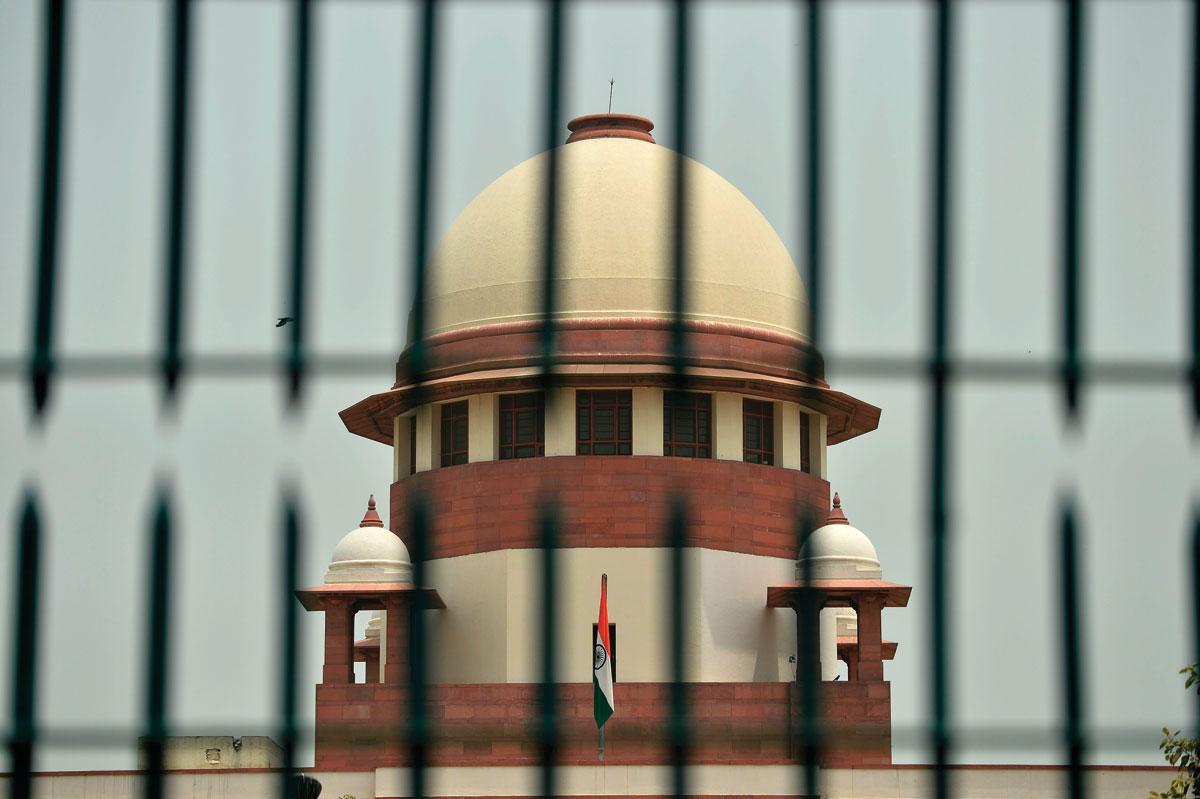The Great Dissent of the Four – Supreme Court on Trial
In this photograph taken on May 26, 2016, the Indian Supreme Court building is seen in New Delhi. Four judges at the Supreme Court of India said January 12 that the independence of the country’s highest judicial authority was threatened, in a rare public intervention. (Sajjad Hussain/AFP/Getty Images)
In a first of its kind event in India, four senior most judges of the Supreme Court mounted a virtual revolt against the Chief Justice of India (CJI), Dipak Misra, raising a litany of serious grievances they said are afflicting the highest court of the land and warned that if unresolved these could destroy the democracy of the country, writes Priyanka Bhardwaj.
At the joint press conference “to save democracy,” held by Justices Jasti Chelameswar, Ranjan Gogoi, Madan B. Lokur and Kurian Joseph at Chelameswar’s official residence, they made public the November 17, 2017 letter to the CJI in which they tried in vain to draw his attention to undertake remedial actions against many issues they felt are not in order.
Among these charges was the allocation of cases by the CJI himself that compromised the integrity of the court.
The letter threw light on the ways in which “the overall functioning of the justice delivery system,” the “independence of the high courts,” and the functioning of the office of the CJI have been “adversely affected.”
Further, the judges clarified that while “nobody is breaking ranks,” theirs is an appeal to the Indian “Nation,” lest “wise people” say later that they were complicit.
What added to the media-tizzy was the affirmation of Gogoi that the allocation of the case pertaining to the investigation into the death of special Central Bureau of Investigation Judge B.H. Loya to a junior judge was the immediate trigger of the dissent.
Historically speaking this is the second crisis in the apex court it has faced, the first witnessed in 1976 at the time of Emergency, when five judges dissented against Indira Gandhi, the then Prime Minister.
Closely looking at the primary cause of friction in the current scenario the dissenting judges allege that the Constitutional Bench that has ruled the CJI to be the “master of roster” is for the sake of maintaining a discipline and efficient transaction of business of the court, and not for recognition of any superior authority, legal or factual, of the CJI over his colleagues.
“The CJI is only the first among equals — nothing more or nothing less,” they reiterated and held him guilty of bypassing the “senior” judges in allocating important cases to junior ones.
Firstly, it must be noted that the Supreme Court is made of twenty-five judges in all and who are equal in competence, experience and eminence.
If the CJI is to be considered the first amongst equals, as he has only one vote, then it is incomprehensible as to how the principle of seniority should be extended with respect to the rest of the judges.
Secondly, the allegations in the letter, by questioning the manner of constitution of benches also raised doubts over the verdicts, not considered to be of individual judges but of the collective, which by implication means that judges are amenable to influence and corruption, and that the apex court therefore is compromised and hence not to be trusted.
In the past two decades it has been a norm that many significant cases have been referred to select benches presided by junior judges and in multiple cases assigned to senior ones, they are accompanied by junior judges and who have made landmark contributions.
Then there has been a long running feud between the legislature and judiciary for appointments of judges in higher courts.
While in the 1990s the clout of the ruling political party was drastically reduced, in October 2015 the apex court struck down the National Judicial Appointments Commission Act that had proposed that appointments to the higher judiciary should be done by a six-member body headed by the CJI, and including two most senior SC judges, the Union law Minister and two “eminent” selected by a panel including the Prime Minister, the CJI and the leader of the largest Opposition party in Lok Sabha.
After restoring the power of the collegiums of the High Court and Supreme Court to make their own judicial appointments, the Memorandum of Procedure (MoP) between the government and Supreme Court remains.
This is another moot point raised by the warring judges that the government’s long reticence over the MoP which it was asked to “finalize by supplementing it in consultation with the Chief Justice of India” must be regarded as a confirmation.
Quite understandably the charges have caused much anguish among the legal and judicial fraternity, citizens, and political parties who have termed it “unfortunate,” with some calling it “trade union tactics, some lauding it as “heroic” and a few of political leaders such as CPI (M) leader Sitaram Yechury and NCP’s Tariq Anwar even considering farfetched options such as impeachment of the CJI “to get into the depth of goings on in the apex court.”
For now, it seems the ball is in the CJI’s court who has all along been silent but holding meetings with the four judges to thrash out an in-house rectification without the mediation of the government.
It is commonly known that while Justices Lokur and Joseph are to retire by the end of the year, Justice Gogoi is next in line to the post of the CJI and there are serious rifts between the CJI and Justice Chelameswar that was all out in the open when the former quashed the latter’s order in the medical bribery scam case and referred it to another bench of judges citing his roster powers.
Restoring the trust and reverence of the citizens and investors on the Supreme Court will be possible only if this impasse is taken to its logical conclusion on a priority basis.
And this would require a speedy and fair examination of Justice Loya’s death and more importantly a rule-based approach of assigning cases rather than depending on the wish or consideration of an individual or group of judges and which will eventually some gaps for future conjectures and controversies over the independence of judiciary, and further denigration of the stature of the Supreme Court.


